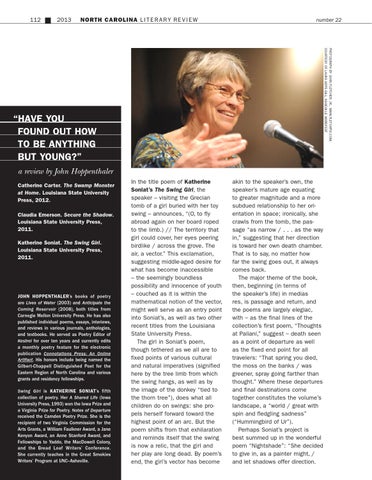112
2013
NORTH CAROLINA L I T E R A R Y RE V I E W
number 22
Photograph By John Fletcher, Jr., www.fletchpix.com; courtesy of Laura Hope-Gill, Asheville Wordfest
“Have you found out how to be anything but young?” a review by John Hoppenthaler Catherine Carter. The Swamp Monster at Home. Louisiana State University Press, 2012. Claudia Emerson. Secure the Shadow. Louisiana State University Press, 2011. Katherine Soniat. The Swing Girl. Louisiana State University Press, 2011.
John Hoppenthaler’s books of poetry are Lives of Water (2003) and Anticipate the Coming Reservoir (2008), both titles from Carnegie Mellon University Press. He has also published individual poems, essays, interiews, and reviews in various journals, anthologies, and textbooks. He served as Poetry Editor of Kestrel for over ten years and currently edits a monthly poetry feature for the electronic publication Connotations Press: An Online Artifact. His honors include being named the Gilbert-Chappell Distinguished Poet for the Eastern Region of North Carolina and various grants and residency fellowships. Swing Girl is Katherine Soniat’s fifth collection of poetry. Her A Shared Life (Iowa University Press, 1993) won the Iowa Prize and a Virginia Prize for Poetry. Notes of Departure received the Camden Poetry Prize. She is the recipient of two Virginia Commission for the Arts Grants, a William Faulkner Award, a Jane Kenyon Award, an Anne Stanford Award, and Fellowships to Yaddo, the MacDowell Colony, and the Bread Loaf Writers’ Conference. She currently teaches in the Great Smokies Writers’ Program at UNC–Asheville.
In the title poem of Katherine Soniat’s The Swing Girl, the speaker – visiting the Grecian tomb of a girl buried with her toy swing – announces, “(O, to fly abroad again on her board roped to the limb.) // The territory that girl could cover, her eyes peering birdlike / across the grove. The air, a vector.” This exclamation, suggesting middle-aged desire for what has become inaccessible – the seemingly boundless possibility and innocence of youth – couched as it is within the mathematical notion of the vector, might well serve as an entry point into Soniat’s, as well as two other recent titles from the Louisiana State University Press. The girl in Soniat’s poem, though tethered as we all are to fixed points of various cultural and natural imperatives (signified here by the tree limb from which the swing hangs, as well as by the image of the donkey “tied to the thorn tree”), does what all children do on swings: she propels herself forward toward the highest point of an arc. But the poem shifts from that exhilaration and reminds itself that the swing is now a relic, that the girl and her play are long dead. By poem’s end, the girl’s vector has become
akin to the speaker’s own, the speaker’s mature age equating to greater magnitude and a more subdued relationship to her orientation in space; ironically, she crawls from the tomb, the passage “as narrow / . . . as the way in,” suggesting that her direction is toward her own death chamber. That is to say, no matter how far the swing goes out, it always comes back. The major theme of the book, then, beginning (in terms of the speaker’s life) in medias res, is passage and return, and the poems are largely elegiac, with – as the final lines of the collection’s first poem, “Thoughts at Paliani,” suggest – death seen as a point of departure as well as the fixed end point for all travelers: “That spring you died, the moss on the banks / was greener, spray going farther than thought.” Where these departures and final destinations come together constitutes the volume’s landscape, a “world / great with spin and fledgling sadness” (“Hummingbird of Ur”). Perhaps Soniat’s project is best summed up in the wonderful poem “Nightshade”: “She decided to give in, as a painter might, / and let shadows offer direction.
